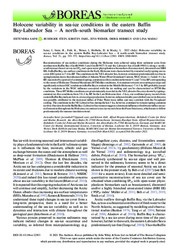Holocene variability in sea‐ice conditions in the eastern Baffin Bay‐Labrador Sea – A north–south biomarker transect study
DOI: https://doi.org/10.1111/bor.12583
Persistent URL: http://resolver.sub.uni-goettingen.de/purl?gldocs-11858/10239
Persistent URL: http://resolver.sub.uni-goettingen.de/purl?gldocs-11858/10239
Saini, Jeetendra; Stein, Ruediger; Fahl, Kirsten; Weiser, Jens; Hebbeln, Dierk; Madaj, Lina, 2022: Holocene variability in sea‐ice conditions in the eastern Baffin Bay‐Labrador Sea – A north–south biomarker transect study. In: Boreas, Band 51, 3: 553 - 572, DOI: 10.1111/bor.12583.
 |
Dokument öffnen: |
Reconstructions of sea‐surface conditions during the Holocene were achieved using three sediment cores from northeastern Baffin Bay (GeoB19948‐3 and GeoB19927‐3) and the Labrador Sea (GeoB19905‐1) along a north–south transect based on sea‐ice IP25 and open‐water phytoplankton biomarkers (brassicasterol, dinosterol and HBI III). In Baffin Bay, sea‐surface conditions in the Early Holocene were characterized by extended (early) spring sea ice cover (SIC) prior to 7.6 ka BP. The conditions in the NE Labrador Sea, however, remained predominantly ice‐free in spring/autumn due to the enhanced influx of Atlantic Water (West Greenland Current, WGC) from 11.5 until ~9.1 ka BP, succeeded by a period of continued (spring–autumn) ice‐free conditions between 9.1 and 7.6 ka BP corresponding to the onset of Holocene Thermal Maximum (HTM)‐like conditions. A transition towards reoccurring ice‐edge and significantly reduced SIC conditions in Baffin Bay is evident in the Middle Holocene (~7.6–3 ka BP) probably caused by the variations in the WGC influence associated with the ice melting and can be characterized as HTM‐like conditions. These HTM‐like conditions are predominantly recorded in the NE Labrador Sea area shown by (spring–autumn) ice‐free conditions from 5.9–3 ka BP. In the Late Holocene (last ~3 ka), our combined proxy records from eastern Baffin Bay indicate low in‐situ ice algae production; however, enhanced multi‐year (drifted) sea ice in this area was possibly attributed to the increased influx of Polar Water mass influx and may correlate with the Neoglacial cooling. The conditions in the NE Labrador Sea during the last 3 ka, however, continued to remain (spring–autumn) ice‐free. Our data from the Baffin Bay–Labrador Sea transect suggest a dominant influence of meltwater influx on sea‐ice formation throughout the Holocene, in contrast to sea‐ice records from the Fram Strait area, which seem to follow predominantly the summer insolation trend. image
Statistik:
ZugriffsstatistikSammlung:
- Geologie [933]
Schlagworte:
Baffin BayLabrador Sea
sediment cores
Holocene
biomarker transect
sea-surface conditions
palaeoceanographic reconstruction
This is an open access article under the terms of the Creative Commons Attribution License, which permits use, distribution and reproduction in any medium, provided the original work is properly cited.

